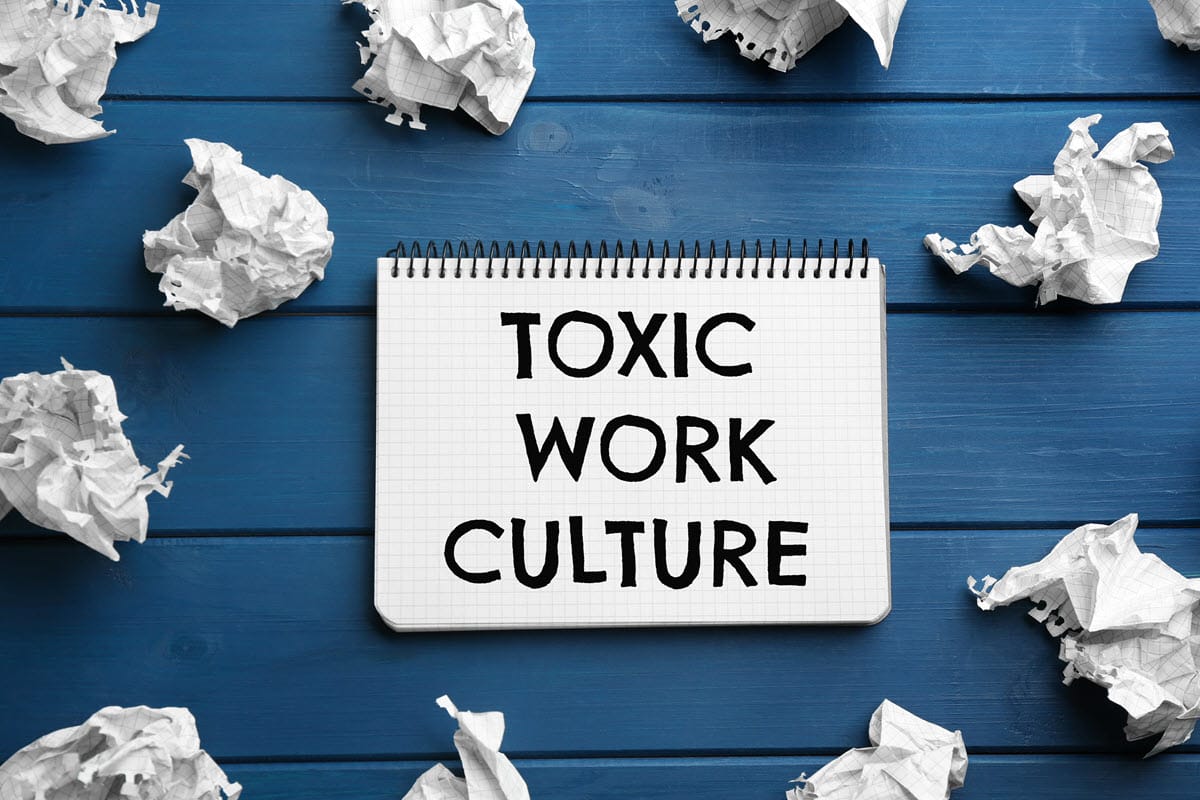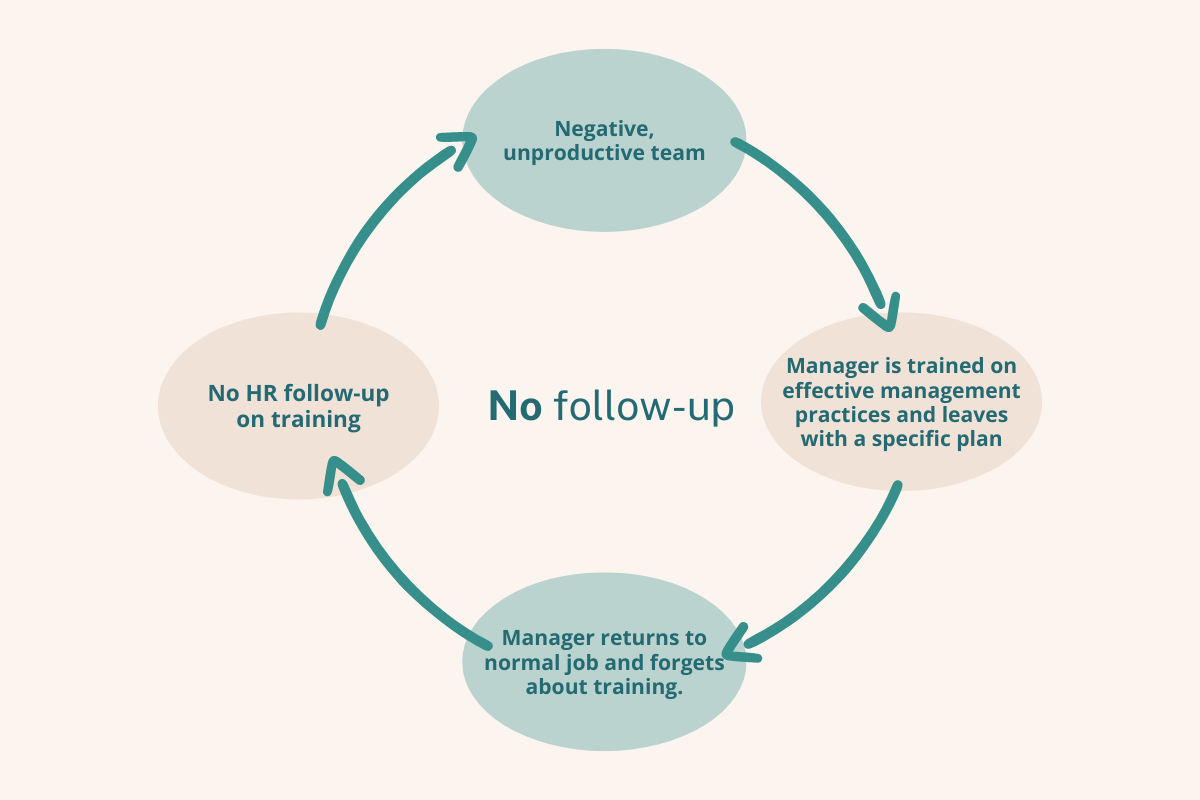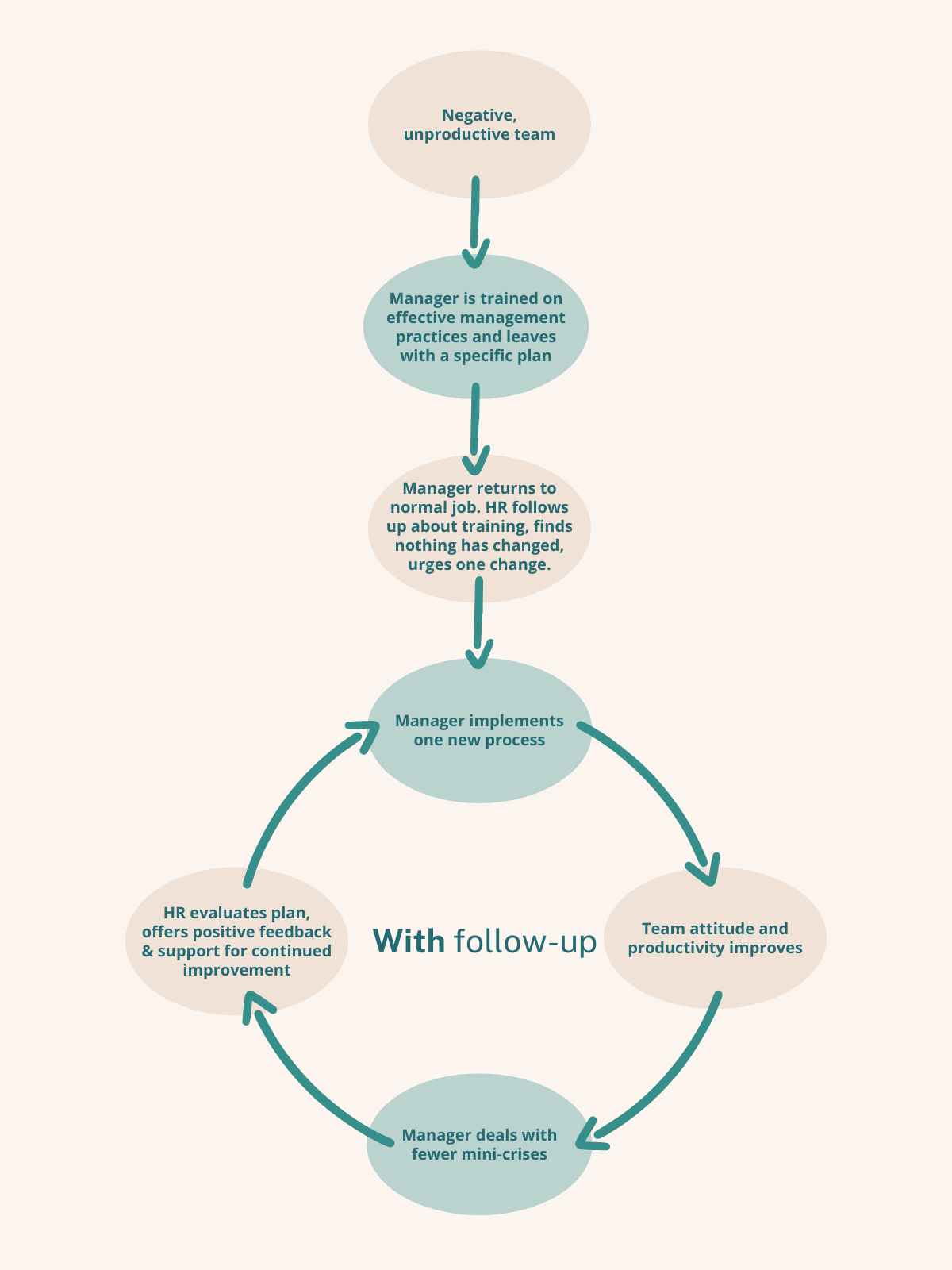Bad company culture can destroy an organization from within, leading to high turnover, poor morale, and low productivity. This article will show you how to spot the signs of a toxic workplace that are the result of bad company culture, understand the impact, and offer practical solutions to improve culture in the workplace.
Key Takeaways
- Key warning signs of a toxic company culture include poor leadership, high turnover, and lack of communication.
- HR leaders can improve company and organizational culture by defining core values, enhancing management practices, and promoting open communication.
- Proactive strategies such as gathering employee feedback and fostering collaboration are essential for preventing future culture problems.
Recognizing Toxic Workplace Culture
Recognizing the warning signs of a toxic culture in the workplace is crucial for addressing it effectively. Some of the most common signs include:
- Poor leadership
- High employee turnover
- Lack of communication
- Excessive internal conflicts
- Rampant gossip
- Low productivity
- Absenteeism
- Employee tardiness
- Employees skipping lunch, breaks, or socialization events
Identifying these signs allows HR leaders to take proactive measures to address issues and build a strong company culture. Let’s take a deeper look at some of the bigger red flags.
Undefined Core Values
Without clearly defined core values, a company may face internal inconsistencies and struggle with its brand identity. Unclear core values can lead to further confusion.
Core values serve as a foundational element of a company’s employee value proposition and culture, creating positive attitudes and a sense of togetherness among employees. By identifying them as part of negative workplace culture, you can take the first step in improving.
Poor Management Practices
Ineffective management practices, such as micromanagement and lack of support, create a toxic work environment where employees feel undervalued. A bad management style leads to a lack of support for employees, contributing to high attrition rates and a toxic workplace culture. Such practices increase turnover rates and emphasize the need for management to adopt supportive approaches to foster a positive workplace culture.
Unhappy employees often result from poor management, and this disengagement can lead to lower productivity. When employees feel micromanaged or unsupported, they are more likely to experience burnout and distrust leadership, all of which are warning signs of a bad company culture and can negatively impact employee morale.
Enhancing management practices is vital for cultivating a supportive and positive work environment.
High Employee Turnover
High turnover rates often signal underlying cultural problems within a company. One out of five employees has left their jobs due to workplace culture in the last five years.
A toxic work culture significantly impacts turnover rates by fostering an environment of dissatisfaction and disengagement. When employees experience frequent conflict, lack of support, or unfair treatment, they are more likely to seek new opportunities elsewhere. High turnover not only disrupts team cohesion and productivity but also incurs additional costs related to recruitment and training.
Holding exit interviews can provide valuable insights into the reasons behind employee turnover and help identify areas for improvement. Effective communication and realistic expectations can reduce turnover and maintain a positive workplace culture. Addressing the root causes of a toxic work culture is crucial for retaining talent and maintaining a positive, productive workplace.
The Impact of Bad Company Culture

The consequences of a bad company culture extend beyond just unhappy employees. A toxic work environment can lead to severe negative outcomes, including high employee turnover, decreased morale, and a tarnished organizational reputation. Various problems such as low productivity, absenteeism, and poor employee retention arise from toxic work cultures.
Recognizing these impacts will equip HR leaders to take corrective measures.
Decreased Productivity
Decreased productivity is a significant consequence of a toxic work culture. Disengaged employees and burnout drastically affect productivity levels. Financial costs associated with a toxic environment include reduced productivity and high turnover.
Promoting regular breaks and effective leadership communication can boost productivity and overall employee wellbeing.
Increased Absenteeism
Unrealistic expectations and excessive workloads can lead to employee burnout, resulting in increased absenteeism. Negative relationships or problematic behavior among employees can cause them to avoid work, indicating their disinterest. Poor communication and lack of support from management are other significant contributors to high absenteeism rates.
Tackling these issues is key to reducing absenteeism and sustaining a positive workplace culture.
Mental Health Issues
A toxic work culture can actively harm employees, leading to increased mental health issues and dissatisfaction. Common contributors to excessive stress include being overworked, uncertainty about expectations, and disagreements with bosses or co-workers. Chronic stress can manifest in physical symptoms like anxiety and fatigue, further diminishing productivity and overall well-being.
Lack of trust in the workplace creates barriers, making it difficult for employees to engage and collaborate effectively. Supportive practices and open communication can significantly improve employee wellbeing and foster a positive work culture.
Common Causes of Toxic Work Environments

Pinpointing the root causes of toxic work environments is crucial for addressing and preventing them. Poor management practices, lack of communication, unhealthy competition, inconsistent policies, bad processes, favoritism, and excessive red tape are common culprits.
Understanding these causes can help HR leaders implement effective solutions to create a positive workplace culture.
Lack of Communication
Poor communication channels create misunderstandings and mistrust among team members. Ineffective communication strategies ultimately lead to a decline in overall productivity. Meanwhile, toxic gossip can result in distrust and bullying, creating a hostile environment.
Effective communication and timely addressing of toxic behaviors are vital for eliminating a negative workplace culture and fostering a more positive one.
Unhealthy Competition
Excessive focus on competition can erode camaraderie and build antagonism between coworkers. While some degree of competition can be good, too much will lead to a focus on winning over all else – including quality. Conflicting incentives within an organization can lead to teams not functioning well and achieving neither of the conflicting goals.
Promoting collaboration over competition is key to maintaining positive workplace relationships and harmony.
Inconsistent Policies
Inconsistent application of company policies can lead to confusion and resentment among colleagues, while poorly structured policies will have similar negative effects within the entire company.
Clear and consistently applied policies are fundamental for maintaining a positive workplace culture.
Bad Processes
Inefficient or unnecessary processes can significantly hinder productivity and morale. Employees want to feel valued, and by completing unnecessary steps, repeating tasks for the sake of the process, it’s hard for employees to feel like their work is valuable. It’s easy to see how this can frustrate employees and contribute to a negative workplace culture
Optimizing processes so employees are doing the most valuable work is vital for fostering a positive workplace culture.
Favoritism
Favoritism in the workplace undermines trust and morale, as it creates an uneven playing field where certain employees receive preferential treatment based on personal relationships rather than merit. This can lead to resentment and decreased motivation among staff who feel that their efforts are overlooked or undervalued. Favoritism creates hostility between coworkers and even supervisors.
Favoritism after a merger or acquisition can be especially harmful. Employees of the acquiring company may feel more powerful and favor its own employees, while discounting ideas and processes of the acquired company workers. Effective management should strive to ensure fairness and transparency, fostering an environment where all employees have equal opportunities to succeed based on their performance and contributions.
Red Tape
Excessive red tape can make simple tasks incredibly challenging and demoralizing for employees. University staff, for example, report that bureaucratic tasks consume valuable time that could otherwise be dedicated to teaching and research. This excessive bureaucracy communicates a lack of trust in employees, damaging workplace relationships.
Cutting through red tape is necessary for improving morale and productivity. Excessive red tape hinders creativity and innovation; identifying and eliminating unnecessary regulations fosters a more positive workplace culture.
Addressing Toxic Work Culture

Transforming bad company culture requires concerted effort and commitment. Key steps include establishing core company values, refining management practices, streamlining processes, reducing red tape, and fostering open communication.
These solutions help create a positive workplace culture and improve overall employee wellbeing.
Define and Communicate Core Values
Core values serve as a foundational element of a company’s culture, guiding decision-making and behavior. Clearly defined core values help align actions across the organization and ensure that the company is living by these values.
Once core values are defined, effective communication of these values is necessary to ensure everyone across the organization is moving toward a more positive company culture.
Communicating core values may not be enough, however. Employees that simply refuse to honor a company’s core values often spread their own unmatched values or negative approach to other employees. A process on how to deal with these situations must be developed and followed to ensure all employees are on board with the organization’s core values.
Improve Management Practices
Ineffective management practices can result in disengaged employees and lower productivity levels. Toxic leadership behaviors such as authoritarian control, abuse of supervisor responsibilities, and lack of empathy for employees can foster a toxic corporate culture characterized. Employees can become afraid, stressed, or disengaged. Alternatively, leadership that focusses on integrity, accountability, and caring for people can transform bad culture in the workplace.
Implementing leadership training programs is an integral step to improve this situation. The training should focus on recognizing toxic behaviors and fostering a supportive environment.
Once training has taken place, it is vital to follow it up with implementation steps and evaluation of the results. Too often training is conducted and then dismissed when busy managers feel they have higher priorities. This can become a vicious circle though, since the “higher priorities” are often issues caused by the poor management practices.
Processes must be put in place that deal with leadership which refuses to improve management processes after training and follow up has taken place. Supportive leaders with excellent management skills have a major effect on promoting a positive workplace culture and achieving its resulting benefits.
Improve Processes
Optimizing processes is crucial for creating a positive workplace culture. Begin by identifying employee struggles and gathering feedback through surveys or interviews. Then prioritize areas for improvement.
Most employees doing a job can think of more efficient ways that the job can be done. Do they keep their ideas to themselves and just sigh as they see the inefficiencies all around them? Have they tried to implement change before but recieved negative responses or poor support? These are opportunities for management to step in and capitalize on the opportunity to improve processes, and company culture.
Streamlining processes motivates employees and enhances their overall experience. By showing your team that their input matters and actually makes a difference in removing frustrating processes, their outlook improves as does their future input and productivity. Empowering employees with decision-making autonomy and ownership of their work enhances management practices.
Remove Excessive Red Tape
Excessive bureaucracy and red tape often results from a lack of empathy, hindering communication and decision-making. Empowering employees to make rule application judgments can significantly reduce red tape and improve work culture.
Designate responsibility for assessing the practicality of rules and procedures. This ensures support, rather than obstruction, when it involves employees’ performance and overall outlook.
Establish Open Lines of Communication
Positive communication improves employee empowerment, productivity, and mood. Multiple feedback avenues enhance transparency and address employee concerns effectively. Gratitude practices and recognition programs foster a supportive work environment and remind employees of their value.
A proactive approach that fosters open communication and transparency can also decrease gossip in the workplace. Encouraging employees to address concerns directly with the individuals involved rather than discussing them behind closed doors helps minimize the spread of rumors. Establishing clear channels for feedback and maintaining regular, honest updates from management can reduce uncertainty and speculation. Additionally, promoting a culture of respect and inclusivity where employees feel valued and heard can diminish the allure of gossip as a means of coping with dissatisfaction. By addressing underlying issues and reinforcing positive communication practices, organizations can create a more focused and collaborative work environment.
An open culture where employees feel heard and valued is vital for maintaining a positive workplace culture. Regular check-ins, open discussions, and multiple feedback channels ensure employees feel supported and engaged.
View Culture Challenges as an Opportunity for Growth
The viewpoint of managers and HR amid bad company culture can have a significant effect on change for the better. As each challenge is discussed and solutions are implemented, viewing them as opportunties for growth puts a positive spin on the situation and results in a better outcome. If turnover occurs, look for the best replacement rather than hurrying to hire and then finding someone who makes the environment worse. When there are misunderstandings and employees are unhappy, its an opportunity to listen and then establish better communication channels.
Preventing Future Culture Problems

Preventing future culture problems requires ongoing efforts and proactive strategies. Here are some steps HR leaders can take to build an organization’s culture moving forward:
- Foster meaningful and honest conversations with employees
- Regularly gather employee feedback.
- Recognizing and reward employees with positive reinforcement
- Promote work-life balance
- Offer flexible work arrangements where possible
- Support and grow talent that is interested in progressing
By taking these steps, your HR department can establish a path to a work culture that pleases new hires and current employees alike.
Summary
Recognizing the warning signs of toxic work culture, understanding its impact, identifying common causes, and implementing effective solutions are crucial steps for fostering a positive workplace culture.
Establishing core values, improving management practices, enhancing processes, removing excessive red tape, and maintaining open lines of communication are essential strategies for creating a supportive and thriving work environment.
By taking proactive measures, HR leaders can transform their company’s culture and ensure long-term success.




